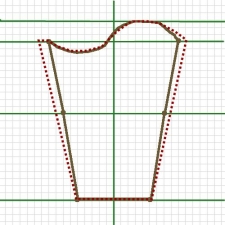 I’ve only ever draped sleeves.. or left them for last and just kind of faked it. This time I want to draft a pattern so I have a sleeve pattern to use on my next dress. I’m planning to make a bunch of German dresses so it seems silly to have to fake the sleeves every time.
I’ve only ever draped sleeves.. or left them for last and just kind of faked it. This time I want to draft a pattern so I have a sleeve pattern to use on my next dress. I’m planning to make a bunch of German dresses so it seems silly to have to fake the sleeves every time.
So.. I grepped the Intarwebs and found a bunch of sites saying a bunch of ways to do it. Luckily one stuck out.
Marion McNealy of Curious Frau has posted a very helpful article about drafting sleeves. This pattern ends up with the sleeve seam on the back of the arm instead of in the armpit.
The measurements:
Straight arm length: 21″
Bent arm length: 24″
Shoulder to elbow: 10.5″
Biceps + 3″ ease: 25.5″
Elbow + 3″ ease: 16″
Hand + 2″ ease: 13″
Armed with this and a measuring tape I went to town. I measured out a string around the armhole of my nearly altogether dress and I drafted my sleeve. Then got to the part where you lay your string over the top of your sleeve.. and I slammed into a wall. My string didn’t make a nice lazy S curve that draped over the top of the sleeve in a lovely manner.. instead my string was barely long enough to go from point A to point B at the top of the sleeve in a straight line. I was certain that a straight line won’t cut it for set-in sleeves.
So.. I officially gave up on drafting. Drafting is not my thing. New plan: go back to draping.
Edith came over an helped me with this on 4/28.
Sleeve Draping Steps:
– Cut out a rectangle of non-stretchy fabric the size of my bidep+3 inches ease by length of arm bent+ a few inches.
– Line this up with the sleeve seam running down the back of the arm (not the armpit). It “seems” right.
– Pin the rectangle to the top of the arm hole (may need to leave 2-3 inches of extra fabric above the arm hole so you have room for the rest of the adjustments).
– Move the arm so you’re reaching forwards and all the way across your chest and have your helper pin at the back of the arm.
– Continue to move the arm and pin all around the arm hole making sure that no matter where you put your arm you have full freedom of movement. You may need to snip the sleeve rectangle in order to free up the arm to get full range of motion and to get the rectangle to line up with the dress arm hole.
– Pin down the length of the arm to get a relative snug fit (not skin tight but not excessively loose).
– Make sure that you like how far up your arm you can push the wrists (specifically I want to be able to wash dishes while wearing this dress so I need to make sure the arms can push up to my elbow or I’ll need to add buttons/laces (which I don’t want to do)). Re-pin as necessary to get the fit and freedom of movement you want.
– Mark the seam at the arm hole and the seam down the arm.
– Even out the seam down the length of the arm.**
– Cut out the new arm based on the evened out seams and the slightly S-curved sleeve cap.
– Trace this on a big piece of paper or posterboard and add seam allowance to all sides.
– Using this new pattern piece, cut out your sleeve in your fashion fabrics.
The sleeve cap actually did come out mostly flat. Not as completely flat as it was looking when I tried to draft the sleeve with the string method.. but damned close to that. So now I have a pattern to use for all the rest of the German Dresses I plan to make.
Using my new pattern I cut out two sleeves, seamed them down the back of the arm(the seam is enclosed between the lining and the outer fabric), attached them to the dress and added my cuffs. I think the cuffs are too long but I’ll try them out for a while and see how they work.
On the next dress I may make the cuffs integral (part of the sleeves). In this case they’re an added bit at the bottom of the sleeve.(see cuffs in this picture. Incidentally, I -love- the strips she used on the top of her sleeve. Must remember that for later.)
**there’s a whole article here about “evening up pinned snorking” but I’m not going to write it now. Maybe later.